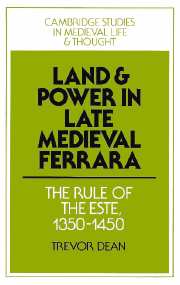Book contents
- Frontmatter
- Contents
- List of maps
- Preface
- List of abbreviations
- Note on sources
- Note on money, measurements and terms
- 1 Introduction
- 2 The Este patrimony
- 3 The Este vassals and their fiefs
- 4 Feudal tenure at Ferrara
- 5 Noble society at the centre
- 6 Noble society in the provinces
- Conclusion
- Appendices
- Bibliography
- Index
- Frontmatter
- Contents
- List of maps
- Preface
- List of abbreviations
- Note on sources
- Note on money, measurements and terms
- 1 Introduction
- 2 The Este patrimony
- 3 The Este vassals and their fiefs
- 4 Feudal tenure at Ferrara
- 5 Noble society at the centre
- 6 Noble society in the provinces
- Conclusion
- Appendices
- Bibliography
- Index
Summary
Until recently, the history of late medieval principalities was conceived largely as the history of their central institutions. This was the picture of the ‘Renaissance state’, ‘unitary, absolute and secular’ (Jones), with centrally-directed administrative, diplomatic and military organisations. Much attention has remained fixed on central institutions, on the prince and his court as the signs of a transition from medieval to modern government. Most recently, the court has been propounded as the instrument of cultural and political unification. This transition from lordship (seigneurie) to principality has long been familiar in French late-medieval historiography. The chief features are rapidly rehearsed: the use of new titles (Dei gratia) and ceremonies (coronations), the claim to regalian rights (coinage, rights over vacant churches), judicial autonomy and the construction of appellate jurisdictions, taxation and institutions of government such as a chancery, archive, treasurers and auditors (chambre des comptes), a professional council with judicial functions and a court. Much of this can be found in the Italian principalities, as we have seen: the pursuit of titles (of duke or marquis and the use of Dei gratia); the appropriation and invention of ceremonies and rituals;3 the claim to imperial status and rights;4 the establishment of courts and jurisdictions and the creation of central institutions.5 The Italian princes' construction of new forms of government has also been seen in their assertive building programmes: both in the city (new castles and palaces, new churches associated with the dynasty) and in the countryside (villas).
- Type
- Chapter
- Information
- Land and Power in Late Medieval FerraraThe Rule of the Este, 1350-1450, pp. 179 - 184Publisher: Cambridge University PressPrint publication year: 1987



